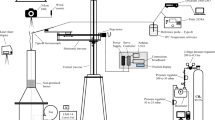Abstract
The effect of fuel concentration gradient on the propagation characteristics of tribrachial (or triple) flames has been investigated experimentally in both two-dimensional and axisymmetric counterflows. The gradient at the stoichiometric location was controlled by the equivalence ratios at the two nozzles; one of which is maintained rich, while the other lean. Results show that the displacement speed of tribrachial flames in the two-dimensional counterflow decreases with fuel concentration gradient and has much larger speed than the maximum speed predicted previously in two-dimensional mixing layers. From an analogy with premixed flame propagation, this excessively large displacement speed can be attributed to the flame propagation with respect to burnt gas. Corresponding maximum speed in the limit of small mixture fraction gradient was estimated and the curvefit of the experimental data substantiates this limiting speed. As mixture fraction gradient approaches zero, a transition occurs, such that the propagation speed of tribrachial flame approaches stoichiometric laminar burning velocity with respect to burnt gas. Similar results have been obtained for tribrachial flames propagating in axisymmetric counterflow.
Similar content being viewed by others
Abbreviations
- a,b, c :
-
Constants
- t :
-
Time after laser shot [ms]
- V o :
-
Nozzle exit velocity
- S d :
-
Flame displacement speed
- S o L st :
-
Stoichiomtric laminar burning velocity
- S tri :
-
Propagation speed of tribrachial flame
- Y f :
-
Mass fraction of methane
- z :
-
Axial coordinate
- φ R :
-
Equivalence ratio of rich condition
- φ L :
-
Equivalence ratio of lean condition
- ρp :
-
Density
- *:
-
Maximum
- b :
-
Burnt
- F :
-
Fuel
- st :
-
Stoichiometry
- u :
-
Unburned
References
Buckmaster, J. and Matalon, M., 1988, “Anomalous Lewis Number Effects in Tribrachial Flames,”Proc. Combust. Inst., Vol. 22, pp. 1527- 1535.
Cha, M.S. and Chung, S. H., 1996, “Characteristics of Lifted Flames in Nonpremixed Turbulent Confined Jets,”Proc. Combust. Inst., Vol. 26, pp. 121–128.
Chung, S. H. and Lee, B. J., 1991, “On the Characteristics of Laminar Lifted Flames in a Nonpremixed Jet,”Combust. Flame, Vol. 86, pp. 62–72.
Daou, J. and Linan, A., 1998, “The Role of Unequal Diffusivities in Ignition and Extinction Fronts in Strained Mixing Layers,”Combust. Theory Modelling, Vol. 2, pp. 449–477.
Dold, J. W., 1989, “Flame Propagation in a Nonuniform Mixture: Analysis of a Slowly Varying Triple Flame,”Combust. Flame. Vol. 76, pp. 71–88.
Domingo, P. and Vervisch, L., 1996, “Triple Flames and Partially premixed Combustion in Autoignition of Non-premixed Turbulent Mixtures,”Proc. Combust. Inst., Vol. 26, pp.233- 240.
Echekki, T., Chen, J. H., 1998, “Structure and Propagation of Methanol-Air Triple Flames,”Combust. Flame, Vo. 114, pp. 231–245.
Ghosal, S. and Vervisch, L., 2000, “Theoretical and Numerical Study of a Symmetrical Triple Flame using the Parabolic Flame Path Approximation,”J. Fluid Mech., Vol. 415, pp. 227–260.
Im, H. G. and Chen. J. H., 1999, “Structure and Propagation of Triple Flames in Partially Premixed Hydrogen-air Mixtures,”Combust. Flame, Vol. 119, pp. 436–454.
Kioni, P. N., Rogg, B., Bray, K. N. C. and Linan, A., 1993, “Flame Spread in Laminar Mixing Layers: The Triple Flame,”Combust. Flame, Vol. 95, pp. 276–290.
Kioni, P. N., Bray, K. N. C., Greenhalgh, D. A., Rogg, B., 1999, “Experimental and Numerical Studies of a Triple Flame,”Combust. Flame, Vol. 116, pp. 192–206.
Ko, Y. S. and Chung, S. H., 1999, “Propagation of Unsteady Tribrachial Flames in Laminar Non-premixed Jets,”Combust. Flame, Vol. 118, pp. 151–163.
Law, C. K., 1993, inReduced Kinetic Mechanism for Application in Combustion Systems (N. Peters and B. Rogg, Eds.), Lecture Notes, in Physics Series m 15, Springer-Verlag, Berlin, pp. 15–26.
Lee, B. J., Kim, J. S. and Chung, S. H., 1994, “Effect of Dilution of the Liftoff of Nonpremixed Jet Flames,”Proc. Combust. Inst., Vol. 25, pp. 1175–1181.
Lee, B. J., Cha, M. S. and Chung, S. H., 1997, “Characteristics of Laminar Lifted Flames in a Partially Premixed Jets,”Combust. Sci. Technol., Vol. 127, pp. 55–70.
Lee, B. J. and Chung, S. H., 1997, “Stabilization of Lifted Tribrachial Flames in a Laminar Nonpremixed Jet,”Combust. Flame, Vol. 109, pp. 163–172.
Lee S. D. and Chung S. H., 1994, “On the Structure and Extinction of Interacting Lean Methane Air Premixed Flames,”Combust. Flame, Vol. 98, pp. 80–92.
Lockett, R. D., Boulanger, B., Harding, S. C. and Greenhalgh, D. A., 1999, “The Structure and Stability of the Laminar Counter-How Partially Premixed Methane/Air Triple Flame,”Combust. Flame. Vol. 119, pp. 109–120.
Mielenz, O., Schlottmann, F. and Rogg, B., 1999, “Experimental Investigations of Laminar Triple Flames and Triplet Flames in Strained Flow Fields,”Seventeenth ICDERS, Paper no. 215.
Phillips, H., 1965, “Flame in a Buoyant Methane Layer,”Proc. Combust. Inst., Vol. 10, pp. 1277–1283.
Plessing, T., Terhoeven, P., Peters, N. and Mansour, M. S., 1998, “An Experimental and Numerical Study of a Laminar Triple Flame,”Combust. Flame, Vol. 115, pp. 335–353.
Ruetsch, G. R., Vervisch, L. and Linan, A., 1995, “Effects of Heat Release on Triple Flames,”Phys. Fluids, Vol. 7, pp. 1447–1454.
Smooke, M. D., 1982, “Solution of Burner-Stabilized Premixed Laminar Flame by Boundary Value Methods,”J. Computat. Phys., Vol. 48, pp. 72–105.
Veynante, D., Vervisch, L., Poinsot, T., Linan, A. and Ruetsch, G., 1994, “Triple Flame Structure and Diffusion Flame Stabilization,”Proceedings of the Summer Program, Center for Turbulence Research, pp. 55–73.
Author information
Authors and Affiliations
Corresponding author
Rights and permissions
About this article
Cite this article
Ko, Y.S., Chung, T.M. & Chung, S.H. Characteristics of propagating tribrachial flames in counterflow. KSME International Journal 16, 1710–1718 (2002). https://doi.org/10.1007/BF03021673
Received:
Revised:
Issue Date:
DOI: https://doi.org/10.1007/BF03021673



